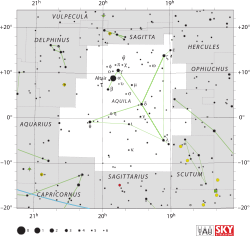Mu Aquilae

| |
| Observation data Epoch J2000 Equinox J2000 | |
|---|---|
| Constellation | Aquila |
| Right ascension | 19h 34m 05.3529s[1] |
| Declination | +07° 22′ 44.189″[1] |
| Apparent magnitude (V) | 4.45[2] |
| Characteristics | |
| Spectral type | K3 III[3] |
| U−B color index | +1.24[2] |
| B−V color index | +1.176[4] |
| R−I color index | 0.61 |
| Astrometry | |
| Radial velocity (Rv) | -24.73 ± 0.13[5] km/s |
| Proper motion (μ) | RA: +213.73[1] mas/yr Dec.: -156.55[1] mas/yr |
| Parallax (π) | 30.31 ± 0.24[1] mas |
| Distance | 107.6 ± 0.9 ly (33.0 ± 0.3 pc) |
| Absolute magnitude (MV) | 1.80[5] |
| Details | |
| Mass | 0.92[5] M☉ |
| Radius | 8[4] R☉ |
| Luminosity | 24.5[4] L☉ |
| Surface gravity (log g) | 2.6[4] cgs |
| Temperature | 4,467[4] K |
| Metallicity [Fe/H] | –0.13[4] dex |
| Rotational velocity (v sin i) | 0.0[4] km/s |
| Other designations | |
Mu Aquilae (μ Aql, μ Aquilae) is the Bayer designation for a star in the equatorial constellation of Aquila. With an apparent visual magnitude of 4.45,[2] it is visible to the naked eye. The measured annual parallax shift of 30.31 mas,[1] which is equivalent to a distance of 107.6 light-years (33.0 parsecs) from Earth.
The stellar classification of Mu Aquilae is K3 III,[3] indicating that this is an evolved giant star. It belongs to a sub-category called the red clump, indicating that it is generating energy through the fusion of helium at its core.[7] Compared to the Sun, it has 92%[5] of the mass but has expanded to eight times the size.[4] This inflated outer envelope has an effective temperature of 4,467 K[4] and is radiating 24.5[4] times the Sun's luminosity. At this heat, Mu Aquilae glows with the orange hue of a K-type star.[8]
References
- 1 2 3 4 5 6 van Leeuwen, F. (November 2007), "Validation of the new Hipparcos reduction", Astronomy and Astrophysics, 474 (2): 653–664, arXiv:0708.1752
 , Bibcode:2007A&A...474..653V, doi:10.1051/0004-6361:20078357.
, Bibcode:2007A&A...474..653V, doi:10.1051/0004-6361:20078357. - 1 2 3 Johnson, H. L.; et al. (1966), "UBVRIJKL photometry of the bright stars", Communications of the Lunar and Planetary Laboratory, 4 (99), Bibcode:1966CoLPL...4...99J.
- 1 2 Morgan, W. W.; Keenan, P. C. (1973), "Spectral Classification", Annual Review of Astronomy and Astrophysics, 11: 29, Bibcode:1973ARA&A..11...29M, doi:10.1146/annurev.aa.11.090173.000333.
- 1 2 3 4 5 6 7 8 9 10 Massarotti, Alessandro; et al. (January 2008), "Rotational and Radial Velocities for a Sample of 761 HIPPARCOS Giants and the Role of Binarity", The Astronomical Journal, 135 (1): 209–231, Bibcode:2008AJ....135..209M, doi:10.1088/0004-6256/135/1/209.
- 1 2 3 4 Hekker, S.; et al. (August 2006), "Precise radial velocities of giant stars. I. Stable stars", Astronomy and Astrophysics, 454 (3): 943–949, arXiv:astro-ph/0604502
 , Bibcode:2006A&A...454..943H, doi:10.1051/0004-6361:20064946
, Bibcode:2006A&A...454..943H, doi:10.1051/0004-6361:20064946 - ↑ "38 Aql -- Variable Star", SIMBAD Astronomical Database, Centre de Données astronomiques de Strasbourg, retrieved 2012-07-18.
- ↑ Alves, David R. (August 2000), "K-Band Calibration of the Red Clump Luminosity", The Astrophysical Journal, 539 (2): 732–741, arXiv:astro-ph/0003329
 , Bibcode:2000ApJ...539..732A, doi:10.1086/309278.
, Bibcode:2000ApJ...539..732A, doi:10.1086/309278. - ↑ "The Colour of Stars", Australia Telescope, Outreach and Education, Commonwealth Scientific and Industrial Research Organisation, December 21, 2004, retrieved 2012-01-16.